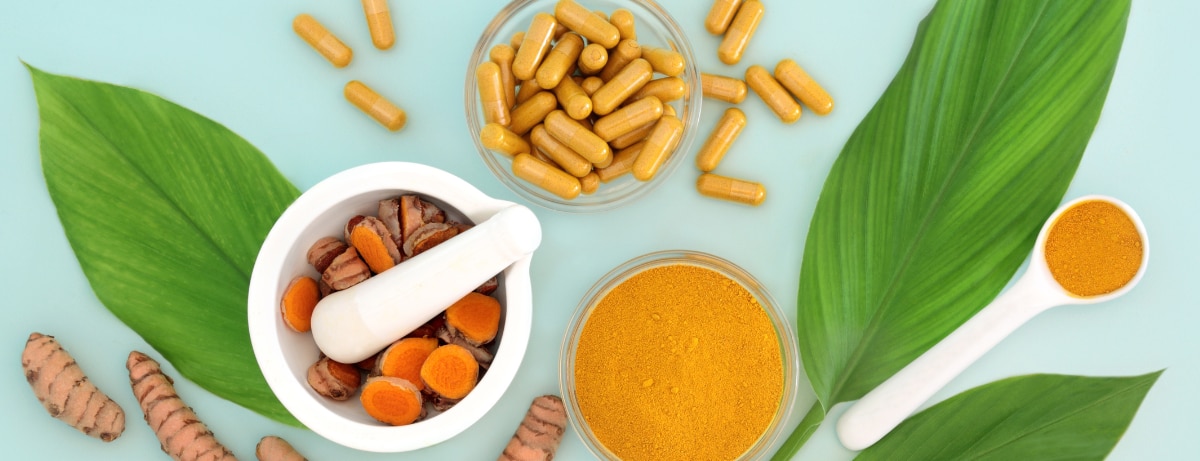10% off £35
Code:SAVE
Turmeric for arthritis and joint pain

What is turmeric, and can it really help with inflammation? Find out more about turmeric, joint pain and inflammation here in our helpful guide.
Summary
1What is arthritis?
Arthritis is a condition which causes inflamed, stiff joints – this can also lead to pain and discomfort.
2Is turmeric good for arthritis?
Turmeric is a bright orange-yellow spice from the root of the turmeric plant, which has been found in lab studies to have potential antibacterial...
3Curcumin and osteoarthritis
Osteoarthritis is the most common form of arthritis. It’s usually caused by wear and tear on the joints, which causes the protective cartilage on...
Turmeric is often said to be beneficial for arthritis, with many discussing the anti-inflammatory and pain-relieving effects of this bright orange spice.1
In this article, we’ll discuss whether turmeric is effective at helping relieve arthritis symptoms, as well as how to add it to your diet.
What is arthritis?
Arthritis is a condition which causes inflamed, stiff joints – this can also lead to pain and discomfort. If you have arthritis, you’re not alone. In the UK, approximately 10 million people have arthritis or other, similar conditions that affect the joints.2 Because of this, there’s an increasing interest in preventative health care for common, chronic conditions such as arthritis.3
Is turmeric good for arthritis?
Turmeric is a bright orange-yellow spice from the root of the turmeric plant, which has been found in lab studies to have potential antibacterial, anti-inflammatory, and antimicrobial properties.1
Native to Southeast Asia, turmeric is from the Zingiberaceae family, the same as ginger. It’s been used for thousands of years in traditional medicine practices for many conditions, including inflammation which causes arthritis.4,5
Turmeric itself contains small amounts of an active compound called curcumin, which some emerging evidence shows may have potent anti-inflammatory properties.1 This is suspected to be down to its antioxidant properties and ability to remove potentially harmful free radicals in the body.6
Some research has also found that curcumin blocks enzymes and other proteins that create an inflammatory response, but most studies were done in animal models or in a petri dish, so more research is needed to see if this would be the same in humans.7
It’s yet to be confirmed for certain as to whether turmeric can help inflammation with conditions like arthritis, but results and anecdotal evidence look promising!
Curcumin and osteoarthritis
Osteoarthritis is the most common form of arthritis.2 It’s usually caused by wear and tear on the joints, which causes the protective cartilage on the ends of bones to break down over time.2
As of 2021, there have been 17 clinical trials looking at whether curcumin can be used as a treatment for osteoarthritis.8 These trials were mixed in both the types of people studied and the methods of ingesting curcumin but in all the studies analysed there was a significant improvement in osteoarthritis.10 Many of the trials recommended that curcumin was eaten and that there weren’t severe side effects.10
It's important to remember though, that studies on turmeric for arthritis haven't all agreed. While some showed benefits, others have been inconclusive or found no improvement. Some studies also aren’t as reliable, because they either didn't have many people involved or didn't do the research quite right.
While there is some indication of turmeric potentially offering relief for some patients with arthritis, the jury is out as to whether it’s actually effective – it’s best to consult your GP before using supplements for arthritis management.
Curcumin and rheumatoid arthritis
Rheumatoid arthritis is caused by the inflammatory response in the body, where the body mistakenly attacks the cartilage between bones and causes it to break down.9 Over time, this damages the joints and causes them to become stiff and painful.11
As with osteoarthritis, the clinical use of turmeric for joint pain – and rheumatoid arthritis – has been suggested since 1989.10 A 2021 review of studies involving the use of curcumin to treat rheumatoid arthritis concluded that in most of these studies, curcumin was found to be effective at treating rheumatoid arthritis.13
Overall, scientists aren't exactly sure how curcumin might help with rheumatoid arthritis in people, with most studies looking at the ways it might work in cells and animals. So it’s worth keeping in mind that more studies on people are needed for definitive results.
How do you use turmeric?
Turmeric has been used as an ingredient in food for thousands of years.11
A standout ingredient in curries, this warming spice can also be added to soups, stews, casseroles, dips, rice, vegetables, tofu, cheese sauce, hummus, pancakes, and even smoothies.
Why not check out some of our favourite recipes?
Recipes
Consuming black pepper alongside your turmeric drastically increases your body’s ability to absorb turmeric’s potential benefits.15 Make sure you keep the two spices together to remind yourself to add a pinch of black pepper – or you could make your own spice blend of the two.
The final say
Turmeric may have potential beneficial effects on arthritis and might help alleviate some of the symptoms according to some initial studies. More robust research in human clinical trials is needed to determine its effectiveness, however, there are some promising results which encourage further study.
If you’re thinking of adding turmeric to your diet, there are a few different ways you can do this:
- added to cooking – turmeric’s bitter taste makes it a great addition to many dishes, including curries
- turmeric hot drinks – teas and coffees are livened up with a bit of turmeric, giving them a distinctive orange colour. Try turmeric tea bags, or you could always make your own turmeric tea
- turmeric tablets – if these don’t sound appealing, you can always try turmeric tablets or capsules
The advice in this article is for information only and should not replace medical care. Please check with your GP or healthcare professional before trying any supplements, treatments or remedies. Food supplements must not be used as a substitute for a varied and balanced diet and a healthy lifestyle.
- Hay E, Lucariello A, Contieri M, Esposito T, De Luca A, Guerra G, Perna A. Therapeutic effects of turmeric in several diseases: An overview. Chemico-biological interactions. 2019 Sep 1;310:108729. Available at: https://www.sciencedirect.com/science/article/abs/pii/S0009279719308610
- Arthritis [Internet]. NHS inform. 2023 [cited 2024 May 22]. Available from: https://www.nhsinform.scot/illnesses-and-conditions/muscle-bone-and-joints/conditions/arthritis/
- Chen A, Gupte C, Akhtar K, Smith P, Cobb J. The Global Economic Cost of Osteoarthritis: How the UK Compares. Arthritis. 2012;2012:698709. doi: 10.1155/2012/698709. Epub 2012 Oct 2. PMID: 23082249; PMCID: PMC3467755. Available at: https://www.ncbi.nlm.nih.gov/pmc/articles/PMC3467755/
- turmeric | Description, History, & Uses [Internet]. Encyclopedia Britannica. Available from: https://www.britannica.com/plant/turmeric
- Verma RK, Kumari P, Maurya RK, Kumar V, Verma RB, Singh RK. Medicinal properties of turmeric (Curcuma longa L.): A review. Int. J. Chem. Stud. 2018;6(4):1354-7. Available at: https://shorturl.at/CST13
- Akter J, Hossain MA, Takara K, Islam MZ, Hou DX. Antioxidant activity of different species and varieties of turmeric (Curcuma spp): Isolation of active compounds. Comparative Biochemistry and Physiology Part C: Toxicology & Pharmacology. 2019 Jan 1;215:9-17. Available at: https://www.sciencedirect.com/science/article/abs/pii/S1532045618301509
- Rahmani AH, Alsahli MA, Aly SM, Khan MA, Aldebasi YH. Role of curcumin in disease prevention and treatment. Advanced biomedical research. 2018 Jan 1;7(1):38. Available at: https://journals.lww.com/adbm/fulltext/2018/07000/role_of_curcumin_in_disease_prevention_and.38.aspx
- Wang Q, Ye C, Sun S, Li R, Shi X, Wang S, Zeng X, Kuang N, Liu Y, Shi Q, Liu R. Curcumin attenuates collagen-induced rat arthritis via anti-inflammatory and apoptotic effects. International Immunopharmacology. 2019 Jul 1;72:292-300. Available at: https://www.sciencedirect.com/science/article/abs/pii/S1567576919307921
- Kulkarni RR, Patki PS, Jog VP, Gandage SG, Patwardhan B. Treatment of osteoarthritis with a herbomineral formulation: a double-blind, placebo-controlled, cross-over study. Journal of ethnopharmacology. 1991 May 1;33(1-2):91-5. Available at: https://www.sciencedirect.com/science/article/abs/pii/037887419190167C
- Shokri-Mashhadi N, Bagherniya M, Askari G, Sathyapalan T, Sahebkar A. A systematic review of the clinical use of curcumin for the treatment of osteoarthritis. Studies on Biomarkers and New Targets in Aging Research in Iran: Focus on Turmeric and Curcumin. 2021:265-82. Available at: https://link.springer.com/chapter/10.1007/978-3-030-56153-6_16
- NHS. Rheumatoid Arthritis [Internet]. NHS. 2023. Available from: https://www.nhs.uk/conditions/rheumatoid-arthritis/
- Srivastava R. Inhibition of neutrophil response by curcumin. Agents and Actions. 1989 Nov;28:298-303. Available at: https://link.springer.com/article/10.1007/BF01967418
- Pourhabibi‐Zarandi F, Shojaei‐Zarghani S, Rafraf M. Curcumin and rheumatoid arthritis: A systematic review of literature. International Journal of Clinical Practice. 2021 Oct;75(10):e14280. Available at: https://onlinelibrary.wiley.com/doi/abs/10.1111/ijcp.14280
- Chattopadhyay I, Biswas K, Bandyopadhyay U, Banerjee RK. Turmeric and curcumin: Biological actions and medicinal applications. Current science. 2004 Jul 10:44-53. Available at: http://repository.ias.ac.in/5196/1/306.pdf
- Hewlings SJ, Kalman DS. Curcumin: A review of its effects on human health. Foods. 2017 Oct;6(10):92. Available at: https://www.mdpi.com/2304-8158/6/10/92
Related Articles
Shop by wellness goal
Sign up for exclusive offers
Plus, get expert advice to support your health & wellness straight to your inbox when you sign up to Holland & Barrett emails.
Read our
privacy policy




















